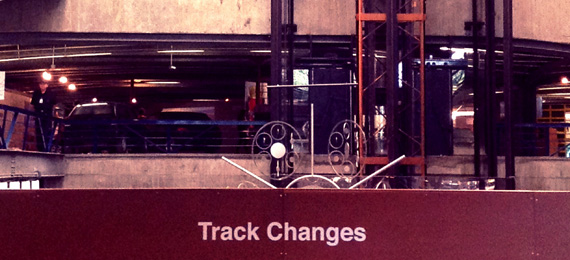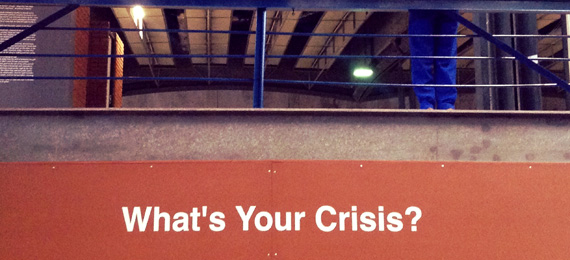The ‘Track Changes‘ program of the 10th São Paulo Architecture biennale, was running for three days at the Centro Cultural São Paulo in November 2013. ‘Track Changes’, curated by Crimson Architectural Historians and organized by the Nieuwe Instituut, consisted of a series of debates focusing on the changing role architects and urbanists can play in the current societal transformations caused by the social, political and economic crises. Failed Architecture was in São Paulo to contribute to this debate and to report on the most important contributions and conclusions of the debates on this page and on our facebook and twitterpages. Comments by Failed Architecture and other participants were made with the #trackchanges hashtag.
The starting point of the series of debates, for which a wide range of spatial professionals from around the world have been invited, was this text. Participants of the Dutch contribution in São Paolo were invited to propose additions, eliminations and alterations, which were recorded in the same way as MS Word’s ‘Track Changes’, hence the name. Using this methodology, the Dutch contribution aimed to ‘track the changes’ related to the shifting position of the spatial professions due to global developments.
The text to which the participants responded provides an outline of the various dimensions of the multiple crises in the Dutch context, and their impact on space making in the Netherlands. It is argued that the financial crisis has heavily impacted construction and therefore architecture, that substantial shifts at the institutional level are forcing architecture in a new position and finally, that the current imbalance between the European, national and local levels regarding governance issues amounts to a defining political crisis.
The curators of ‘Track Changes’ subsequently discern three general responses to these crisis, again, in the Dutch context. Some actors in the spatial sector are already preparing for a post-crisis economic situation, others tend to move their focus abroad, while a third group is exploring new ways of working, which embrace the temporary, the local and the flexible and often materialize in the form of interventions rather than large scale masterplans.
According to the text drafted by Crimson, this approach is not only characteristic for many new projects in the Netherlands, but is ‘popping up’ around the world, from dilapidated inner cities in the Unites States to the slums in the Global South. Currently, the temporary, local and flexible approach is still rather incidental, although it might become more established in the years to come. Before the war, modernist experiments for example were still anomalies, but suddenly became the regulating force in space making after the war. The curators wonder whether the new temporary, local and flexible approach, analogous to the development of modernism, might become the new modus operandi soon.
This line of thinking provided the context for the three separate debates at the ‘Track Changes’, of which you can read all reports below. The pictures shown on this page are taken at the arena built for ‘Track Changes’ at the Centro Cultural São Paulo, assembling both the titles of the debates and the architectural environment of the CCSP.
[report] November 4: Opening debate ‘We the People’
The ‘We The People’ opening debate delved into the possibilities and problems relating to the inclusion of participatory processes in large scale masterplans. First, Wouter van Stiphout from Crimson Architectural Historians explained how participation became an important focus point in Dutch urban planning during the Dutch ‘Gezi Parks’ of the 70s (the riots related to large scale urban restructuring), but also how participation became perceived as an institutionalized obstacle later on. More recently, while participation in planning has disappeared from the radar, the notion of ‘participation’ was reintroduced as a totally different, neoliberal concept: the Dutch prime minister advocated the ‘participation society’, which does not imply influencing decision making processes, but cutting government services and forcing people to solve their own problems.
Kazuo Nakano, director urban development of São Paulo, argued that Brazil’s largest city is following a rather different trajectory. After the implementation of the participative proposals of the previous, 2002 masterplan largely failed, the municipality started a citywide, new participatory process, including more than 150 social actors in the city. In this process, civil society is not just informed about an unchangeable plan, but is involved before anything is actually developed. However, Nakano acknowledges that the private sector is still dominating public-private partnerships in the city.
In order to improve the upcoming masterplan, Carla Fonseca has developed the SampaCriativa participatory project, which is currently collecting proposals by inhabitants of the city. A selection of these will be offered to the municipality and will be considered for inclusion in the masterplan-in-development. A very different approach of enabling the participation of São Paulo’s inhabitants in the development of their city is offered by the Urban Think Tank. Their project in the Paraisopolis favela provided the locals the opportunity to decide on the functions of a new development focusing on the social infrastructure of the neighborhood.
Michelle Provoost of Crimson contrasted these projects with their activities in Hoogvliet, Rotterdam, where they were funded by national and local governments to scale up already existing local initiatives in the neighborhood. She furthermore argued that the investment model of large scal urban plans in São Paulo is the main obstacle for deepening participation by locals, on which among others Nakano agreed. New investment models, in which the private sector is not deciding on every aspect, and the introduction of mediators bringing together different spatial stakeholders might improve participatory processes in the years to come.
[report] November 5: “Bottom up is not enough” debate
The second debate of the ‘Track Changes’ program focused on the growing trend of a kind of urban interventions that are often characterized by temporality, the smaller scale, localism, flexibility and low budgets. The question is whether these interventions can become more than a trend, or, can they move, as Crimson describes, ‘from the avant garde to the center, from the exception to the standard and from the elite to the society?’ A total of seven presentations of projects from around the world operating on various scales provided input for the discussion.
First of all, URBZ presented their work in the Paraisopolis favela in central São Paulo, where they worked with local constructors and inhabitants to improve building methods in the area. Supersudaca showed how the construction of bottom-up, informal housing in Lima did not solve collective issues such as public space and education facilities, after which they constructed an orchard for children of the neighborhood. The Camara project by USINAworked with inhabitants evicted from an informal area and managed to arrange public money to construct affordable housing for them. All these projects had the clear ambition to make their way of working more prominent by aiming to reproduce their achievements, but they stated that further systematization is often hampered by a lack of money or socially engaged architects.
After the initial three ‘Do It Yourself’ projects, a few projects of a slightly larger scale followed. Damon Rich of the City of Newark presented the riverside project in his city, in which an urban wasteland was turned into an attractive waterfront. The Islington Square Housing in Manchester, a small scale redevelopment scheme, was discussed by Charles Holland of FAT Architecture. And finally, returning to the Paraisopolis favela, MMBB presented their so far unfinished proposal to transform a dangerous open sewage into an attractive public space, which will improve the quality of living in the area but also affect many local residents.
The last three projects were characterized by a more significant influence by the state. Besides, they are clearly operating on a larger scale and arguably having a bigger impact on their respective built environments. The suggestion that therefore the state is necessary in scaling up small scale urban interventions was refuted by the audience. It was argued that small scale projects can also just co-exist in larger numbers, provide testing grounds, or used to develop new strategies for other projects. In fact, not only uncertainty was expressed regarding the question whether these small urban interventions will indeed become more prominent in the years to come, but the audience was also warned that these kind of projects should not suggest taking over fundamental tasks of the government.
[report] November 6: “What’s your crisis?” debate
The final debate of the ‘Track Changes’ program aimed to come to an understanding of the role spatial professionals can or should play in the current economic, financial, political and institutional crises. Architects and urbanists from around the world shared their experiences with different ways of working in a wide range of projects, which functioned as input for a discussion among the participants at the Centro Cultural São Paulo.
Wouter Vanstiphout, one of the curators of the program, started the session with a presentation on the different dimensions of the crisis in the Netherlands. Nanne de Ru (director of the Berlage Institute) later added that in the Netherlands at some point the real estate bubble was inflated to such an extent that houses were often making more money per day than its inhabitants did working. It was not that weird then, according to him, that after the bubble bursted architects lost their jobs almost as often as bankers. Vanstiphout furthermore explained that architecture offices often continue to deny this reality or shift their focus abroad.
Others, however, choose to apply different ways of operating, such as ZUS from Rotterdam. Their Luchtsingel project aimed to generate an urban transformation not through a large scale building program, but through small restructuring interventions. A key part of this project, a wooden bridge over a major road in central Rotterdam was successfully crowdfunded. In the non-European contributions that followed however, it soon became clear that ‘crisis’ – understood as the one that originated in the USA in 2008 and impacted in most of Europe – is not a very relevant condition to architects and urbanists in the Global South.
From the various presentations, among others by CRIT from Mumbai and the Brazilian architect Mariana Fix, a picture of a more permanent ‘crisis’ emerged. Brazilian cities were heavily impacted by the debt crisis in the 80s and market-dominated PPP-constructions in the 90s, and the upcoming Olympic Games and World Cup are already causing displacement on a large scale. Housing in Mumbai has been in crisis for decades. This is the context, and not a sudden crisis in the Global North, in which all the non-European participants of the debate (among them also 23SUL and Vazio S/A) are continuing their efforts to improve the urban environment, often with low or no budgets.




